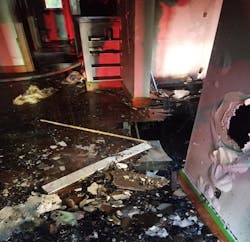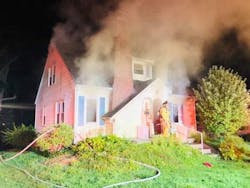11 Lessons Learned: Mayday! OH Firefighter Falls Through Floor
A house fire in Newark, OH, resulted in a mayday being called in an area that was identified as a hazard after the incident was placed under control. We are sharing the details of this incident, the mayday and our operations with the purpose of helping other departments prepare for a similar incident.
At 4:50 a.m. on July 18, 2019, Newark units were dispatched to a residential structure fire at 268 Moull St.
Battalion 1 (BN1) arrived and assumed command. The size-up included: “story-and-a-half, looks like there’s a walkout. I’ll be doing a 360, smoke showing, make it a working fire.”
Rescue 1 (R1) was assigned to fire attack with Engine 2 (E2) being assigned to search. BN1 reported that the 360-degree size-up was completed and found a walkout basement on the C-side of the structure, with “no visible flames, but smoke all the way around." Ladder 1 (L1) was assigned to stretch a back-up hoseline and Ladder 3 (L3) was assigned ventilation.
Crews radio hole found in floor
R1 reported a hole in the first floor, just inside the front door (“Hole Report 1”) and E2 radioed, “We have a basement fire.” R1 confirmed the basement fire report, reiterating hole through the first floor (“Hole Report 2”).
BN1 acknowledged the information and advised crews to back out of the first floor and to redeploy through the C-side walkout. L1 was just deploying their back-up line and was able to reposition to the C-side basement walkout entrance before calling for their hoseline to be charged.
BN1 was having difficulty hearing the radio traffic and moved into the command vehicle while R1 and Medic 3 (M3) worked to reposition the initial charged handline to the C-side.
Due to the change in attack entry locations, the L1 and R1 assignments were switched, leaving L1 to advance the hoseline and R1 to handle the back-up line.
Medic 2 (M2) met with BN1 face-to-face and was assigned to be the initial rapid intervention team (RIT).
BN1 met with L3 and advised them to coordinate ventilation with the attack crew and L3 called L1 on the radio, letting them know they were waiting for their go-ahead to ventilate. L1 acknowledged and shortly after that E2 advised, “Go ahead and get the windows now.”
L1 reported water on the fire, and BN1 repeated the order to take out the windows on the first floor as well as re-opening the front door. L3 opened windows on the A and D sides, forced open the rear door to the first floor, and asked if more ventilation was needed.
At that point, BN1 advised that smoke conditions were lightening and that they should give it a minute to see if more ventilation was necessary. L1 said the fire in the basement had been knocked down and that there were multiple holes in the first floor (“Hole report 3”) and B1 radioed “Copy, multiple holes in the fire floor. Fire is knocked down in the basement” (“Hole report 4”).
Searches and fire extension
E2 shut off the main breaker at the panel and M3 was assigned to search for a gas shutoff and then join M2 to create a four-person RIT crew.
E2 indicated that the primary search of the basement was clear, and they were moving to the first floor where they gave an all clear and then proceeded to the second floor for searches.
With crews tired from working under high temperature and humidity, the chance of a medical event was increasing, and command requested an additional medic unit with all on-scene medic crews operating.
Licking County Regional Communications Center (LCRCC) advised that a 15-minute Personal Accountability Report (PAR) check was needed, and everyone was accounted for.
L3 requested a hoseline to the first floor when they found fire in the wall and R1 moved their back-up line from the basement entrance to the front door. There was no smoke in the basement or first floor, however there was still a moderate amount of smoke coming from the eaves, particularly on the A-side. E391 was assigned to ventilate the roof due to the smoke conditions making a case for fire in the attic.
L1 placed sawhorses next to the burn hole on the first floor to mark its location for other crews on the scene.
More fire discovered
E2 called for a hoseline when they located fire in the knee wall and floor on the second floor because of the carpet bubbling. While moving the hoseline, the sawhorses were inadvertently knocked into the basement.
R1 exited the structure and L3 needed a crew to assist in the search for fire extension and E52 (Victim 2) was assigned to replace R1 on the second floor. LCRCC advised that R1 was communicating on a different radio channel about fire in the second story wall.
BN1 asked E2 for an update on the status of their search and indicated that there was a hole in the floor on the second floor (“Hole Report 5”).
BN1 advised L3 of smoke conditions increasing from the attic and instructed them to ventilate the second floor and they confirmed, adding L1 was working with them to open the attic space. E2 exited, met BN1 and advised that there was a single burn hole on the second floor and there were multiple holes in the floor from missing HVAC grates, but they were not concerned about floor stability. E2's officer (Victim 1) had stepped in one of these uncovered holes and injured his hand while trying to catch himself.
Due to increasing smoke conditions and the injury, BN1 requested two more engine companies and advised Medic 201 that they would have a patient with a hand injury.
L3 reported that the heat conditions on the second floor increased and requested a condition report from BN1. Upon exiting the home, L1 reported that they were pulling a lot of ceiling on the second floor but unable to locate any fire. L3 again reported to BN1 that heat conditions were increasing and they were unable to locate the fire.
From the front yard, L1 notified crews that there was a small amount of fire in the wall on the first floor and exterior crews stretched the bumper line from R1 to address that fire from the exterior. BN1 notified L3 of the fire below them and L3 with E52 advised that they were going to exit the structure.
Mayday called at 32 minutes
At 5:28 a.m., 32 minutes into the incident, “Mayday, mayday, mayday. Mayday, mayday, mayday. We got a firefighter into the basement (Victim 2)” was transmitted by L3. BN1 acknowledged the mayday and activated the RIT crew, directing them to access the basement through the exterior entrance on the C-side and requested an additional alarm for the incident.
LCRCC acknowledged the request and transmitted “All on-scene units besides…command, downed firefighter, and RIT crew take all traffic to OPS2.” The wording of this message confused the RIT companies who immediately turned their radios to OPS2. BN1 turned a portable radio to OPS2 while requesting confirmation that the RIT had been activated on the original fireground channel.
On OPS2, they radioed they had made contact with the downed firefighter and that they were taking him out the back door of the structure.
L3 had attempted to transmit a message on the primary channel and was cut off by second alarm companies. BN1 announced on both channels that RIT had reached the downed firefighter and was assisting him out of the building.
RIT located him quickly and “didn’t hardly let my feet touch the ground” as they assisted him out, but that he walked out under his own power. BN1 met with all companies to let everyone know that the mayday, Victim 2, appeared to be uninjured.
What led to the mayday
While crews were exiting the second floor, a member of L3 stumbled and fell to the ground. E52 firefighter (Victim 2) walked between the firefighter who fell and the burn hole in the first floor. After Victim 2 checked on the L3 firefighter, he turned and headed toward the front door. Victim 2’s left foot was on the edge of the burn hole and the edge gave way, sending him into the basement and taking the handline with him.
The mayday was transmitted by L3’s officer and RIT operations commenced. After exiting, Victim 2 advised that he felt uninjured, adding, “I almost slid into the basement rather than fell,” adding that he does not remember a hard impact. He was adamant that he was uninjured but was advised to dress down and take it easy.
L3’s crew stated that they knew the hole was there and visibility was good, and Victim 2 just ended up too close to the edge. E52's crew stated that they had not seen the hole when they entered the structure and Victim 2 stated that he did not know that there was a hole in the first floor until he ended up falling.
Eleven lessons learned
Following the incident, the department compiled a list of findings that have been turned into actionable items.
- Command needs to ensure all companies assigned to an incident are aware of current conditions, both fire and structural, prior to making entry.
- Personnel need to exercise good radio discipline.
- Call for more resources early when the crews are already fatigued.
- An additional command officer, who is immediately available to respond, should be dispatched at each additional alarm.
- Alterations to the fireground radio traffic model should be made to separate responding units from units that are operating on scene.
- A 360-degree size-up by the incident commander is invaluable.
- Void spaces where fire is located should be opened and completely extinguished when crews are operating above.
- Crews involved in a Mayday should be replaced, and not allowed to continue to perform tasks on the fireground.
- A RIT crew must consist of a minimum of three firefighters.
- Alternate access should be used to avoid known hazards.
- A crew needs to remain at the seat of the fire even after knockdown.
No one starts their shift thinking, “Today is the day we’re going to have a mayday.” There are a variety of factors that should have provided clues that the chance of a mayday was increasing, but if we do not give the incident the respect and attention it deserves, we will miss them.
About the Author
Alan Ashcraft
Alan Ashcraft is a 27-year member of the fire service, currently an assistant chief serving as a shift commander in the Newark, OH, Fire Department. He is an instructor for engine operations, fire officer, strategy/tactics, and leadership programs throughout the state. Ashcraft is a student of the fire service and proud member of the Central Ohio F.O.O.L.S.

